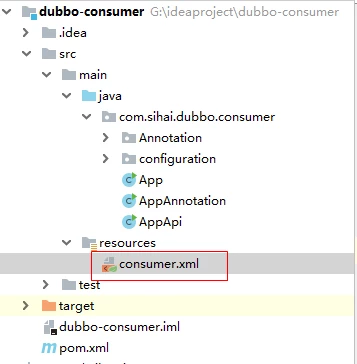初入Dubbo
什么是dubbo
Dubbo是Alibaba开源的分布式服务框架,它最大的特点是按照分层的方式来架构,使用这种方式可以使各个层之间解耦合(或者最大限度地松耦合)。从服务模型的角度来看,Dubbo采用的是一种非常简单的模型,要么是提供方提供服务,要么是消费方消费服务,所以基于这一点可以抽象出服务提供方(Provider)和服务消费方(Consumer)两个角色。关于注册中心、协议支持、服务监控等内容,详见后面描述。 Webservice也是一种服务框架,但是webservice并不是分布式的服务框架,他需要结合F5实现负载均衡。因此,dubbo除了可以提供服务之外,还可以实现软负载均衡。它还提供了两个功能Monitor 监控中心和调用中心。这两个是可选的,需要单独配置。
Dubbo是阿里巴巴SOA服务化治理方案的核心框架,致力于提供高性能和透明化的RPC远程服务调用方案,以及SOA服务治理方案。其核心部分包含:
- 远程通讯: 提供对多种基于长连接的NIO框架抽象封装,包括多种线程模型,序列化,以及“请求-响应”模式的信息交换方式。
- 集群容错: 提供基于接口方法的透明远程过程调用,包括多协议支持,以及软负载均衡,失败容错,地址路由,动态配置等集群支持。
- 自动发现: 基于注册中心目录服务,使服务消费方能动态的查找服务提供方,使地址透明,使服务提供方可以平滑增加或减少机器。
那么,Dubbo能做什么?
- 透明化的远程方法调用,就像调用本地方法一样调用远程方法,只需简单配置,没有任何API侵入。
- 软负载均衡及容错机制,可在内网替代F5等硬件负载均衡器,降低成本,减少单点。
- 服务自动注册与发现,不再需要写死服务提供方地址,注册中心基于接口名查询服务提供者的IP地址,并且能够平滑添加或删除服务提供者。
Dubbo产生的背景
随着互联网的发展,网站应用的规模不断扩大,常规的垂直应用架构已无法应对,分布式服务架构以及流动计算架构势在必行,亟需一个治理系统确保架构有条不紊的演进。
- 单一应用架构
当网站流量很小时,只需一个应用,将所有功能都部署在一起,以减少部署节点和成本。
此时,用于简化增删改查工作量的数据访问框架(ORM) 是关键。 - 垂直应用架构
当访问量逐渐增大,单一应用增加机器带来的加速度越来越小,将应用拆成互不相干的几个应用,以提升效率。
此时,用于加速前端页面开发的Web框架(MVC) 是关键。 - 分布式服务架构
当垂直应用越来越多,应用之间交互不可避免,将核心业务抽取出来,作为独立的服务,逐渐形成稳定的服务中心,使前端应用能更快速的响应多变的市场需求。
此时,用于提高业务复用及整合的分布式服务框架(RPC) 是关键。 - 流动计算架构
当服务越来越多,容量的评估,小服务资源的浪费等问题逐渐显现,此时需增加一个调度中心基于访问压力实时管理集群容量,提高集群利用率。
此时,用于提高机器利用率的资源调度和治理中心(SOA) 是关键。
Dubbo的诞生
在互联网的发展过程中,在以前,我们只需要一个服务器,将程序全部打包好就可以,但是,随着流量的增大,常规的垂直应用架构已无法应对,所以,架构就发生了演变。
- 单一应用架构
- 应用和数据库单独部署
- 应用和数据库集群部署
- 数据库压力变大,读写分离
- 使用缓存技术加快速度
- 数据库分库分表
- 应用分为不同的类型拆分
发展到这个阶段的时候,我们发现,应用与应用之间的关系已经十分的复杂了,就会出现以下几个问题(以下摘录于官网):
- 当服务越来越多时,服务 URL 配置管理变得非常困难,F5 硬件负载均衡器的单点压力也越来越大。
- 当进一步发展,服务间依赖关系变得错踪复杂,甚至分不清哪个应用要在哪个应用之前启动,架构师都不能完整的描述应用的架构关系。
- 接着,服务的调用量越来越大,服务的容量问题就暴露出来,这个服务需要多少机器支撑?什么时候该加机器?
为了解决这由于架构的演变所产生的问题几个问题,于是,dubbo 产生了。当然,解决这个问题的技术不止 dubbo 。
Dubbo技术架构
我们已经非常清楚的知道为什么在我们的系统中需要 Dubbo 这项技术了,下面,我们接着唠叨唠叨 Dubbo 的架构。
首先,上一张图(摘自官网)。
看到图之后,可能你对上面的几个概念还是一脸懵逼,无从下手,下面,带你看看这几个角色到底是什么意思?
节点角色说明
| 节点 | 角色说明 |
|---|---|
| Provider | 暴露服务的服务提供方 |
| Consumer | 调用远程服务的服务消费方 |
| Registry | 服务注册于发现的注册中心 |
| Monitor | 统计服务的调用次数和调用时间的监控中心 |
| Container | 服务运行容器 |
看了这几个概念后似乎发现,其实 Dubbo 的架构也是很简单的(其实现细节是复杂的),为什么这么说呢,有没有发现,其实很像 生产者-消费者 模型。只是在这种模型上,加上了 注册中心和监控中心 ,用于管理提供方提供的 url ,以及管理整个过程。
那么,整个发布-订阅的过程就非常的简单了。
- 启动容器,加载, 运行服务提供者 。
- 服务提供者在启动时,在注册中心 发布注册 自己提供的 服务 。
- 服务消费者在启动时,在注册中心 订阅 自己所需的 服务 。
如果考虑 失败或变更 的情况,就需要考虑下面的过程。
- 注册中心返回服务提供者地址列表给消费者,如果有变更,注册中心将基于长连接推送变更数据给消费者。
- 服务消费者,从提供者地址列表中,基于软负载均衡算法,选一台提供者进行调用,如果调用失败,再选另一台调用。
- 服务消费者和提供者,在内存中累计调用次数和调用时间,定时每分钟发送一次统计数据到监控中心。
通过这番讲解,我相信 Dubbo 的架构我们也轻车熟路了,那就直接就可以直接上手了。
Dubbo开始入门
服务端
首先,我们先把服务端的接口写好,因为其实 dubbo 的作用简单来说就是给消费端提供接口。
接口定义
1 | /** |
这个接口非常简单,只是包含一个 SayHello 的方法。
接着,定义它的实现类。
1 | /** |
这样我们就把我们的接口写好了,那么我们应该怎么将我们的服务暴露出去呢?
导入 maven 依赖
1 |
|
这里使用的 dubbo 的版本是 2.6.6 ,需要注意的是,如果你只导入 dubbo 的包的时候是 会报错 的, 找不到 netty 和 curator 的依赖 ,所以,在这里我们需要把这两个的依赖加上,就不会报错了。
另外,这里我们使用 zookeeper 作为注册中心。
到目前为止,dubbo 需要的环境就已经可以了,下面,我们就把上面刚刚定义的接口暴露出去。
暴露接口(xml 配置方法)
首先,我们在我们项目的 resource 目录下 创建 META-INF.spring 包 ,然后再创建 provider.xml 文件,名字可以任取哦,如下图。
1 |
|
上面的文件其实就是类似 spring 的配置文件,而且,dubbo 底层就是 spring。
节点:dubbo:application 就是整个项目在分布式架构中的唯一名称,可以在 name 属性中配置,另外还可以配置 owner 字段,表示属于谁。 下面的参数是可以不配置的,这里配置是因为出现了端口的冲突,所以配置。
节点:dubbo:monitor 监控中心配置, 用于配置连接监控中心相关信息,可以不配置,不是必须的参数。
节点:dubbo:registry 配置注册中心的信息,比如,这里我们可以配置 zookeeper 作为我们的注册中心。 address 是注册中心的地址,这里我们配置的是 N/A 表示由 dubbo 自动分配地址。或者说是一种直连的方式,不通过注册中心。
节点:dubbo:protocol 服务发布的时候 dubbo 依赖什么协议,可以配置 dubbo、webserovice、Thrift、Hessain、http等协议。
节点:dubbo:service 这个节点就是我们的重点了,当我们服务发布的时候,我们就是通过这个配置将我们的服务发布出去的。 interface 是接口的包路径, ref 是需要配置的接口的 bean。
最后,我们需要像配置 spring 的接口一样,配置接口的 bean。
到这一步,关于服务端的配置就完成了,下面我们通过 main 方法 将接口发布出去。
发布接口
1 | package com.sihai.dubbo.provider; |
发布接口非常简单,因为 dubbo 底层就是依赖 spring 的,所以,我们只需要通过 ClassPathXmlApplicationContext 拿到我们刚刚配置好的 xml ,然后调用 context.start() 方法就启动了。
看到下面的截图,就算是启动成功了,接口也就发布出去了。
你以为到这里就结束了了,并不是的,我们拿到 dubbo 暴露出去的 url 分析分析。
dubbo 暴露的 url
1 | dubbo://192.168.234.1:20880/com.sihai.dubbo.provider.service.ProviderService?anyhost=true&application=provider&bean.name=com.sihai.dubbo.provider.service.ProviderService&bind.ip=192.168.234.1&bind.port=20880&dubbo=2.0.2&generic=false&interface=com.sihai.dubbo.provider.service.ProviderService&methods=SayHello&owner=sihai&pid=8412&qos.accept.foreign.ip=false&qos.enable=true&qos.port=55555&side=provider×tamp=1562077289380 |
分析
首先,在形式上我们发现,其实这么牛逼的 dubbo 也是用 类似于 http 的协议 发布自己的服务的,只是这里我们用的是 dubbo 协议 。
dubbo://192.168.234.1:20880/com.sihai.dubbo.provider.service.ProviderService上面这段链接就是 ? 之前的链接,构成: 协议://ip:端口/接口 。发现是不是也没有什么神秘的。anyhost=true&application=provider&bean.name=com.sihai.dubbo.provider.service.ProviderService&bind.ip=192.168.234.1&bind.port=20880&dubbo=2.0.2&generic=false&interface=com.sihai.dubbo.provider.service.ProviderService&methods=SayHello&owner=sihai&pid=8412&qos.accept.foreign.ip=false&qos.enable=true&qos.port=55555&side=provider×tamp=1562077289380? 之后的字符串,分析后你发现,这些都是刚刚在 provider.xml 中配置的字段,然后通过 & 拼接而成的,闻到了 http 的香味了吗?
终于,dubbo 服务端入门了。下面我们看看拿到了 url 后,怎么消费呢?
消费端
上面提到,我们在服务端提供的只是点对点的方式提供服务,并没有使用注册中心,所以,下面的配置也是会有一些不一样的。
消费端环境配置
首先,我们在消费端的 resource 下建立配置文件 consumer.xml 。 下建立配置文件 consumer.xml 。

1 |
|
分析
发现这里的 dubbo:application 和 dubbo:registry 是一致的。
dubbo:reference :我们这里采用 点对点 的方式,所以,需要配置在服务端暴露的 url 。
maven 依赖
和服务端一样
1 |
|
调用服务
1 | package com.sihai.dubbo.consumer; |
这里和服务端的发布如出一辙。
如此,我们就成功调用接口了。

